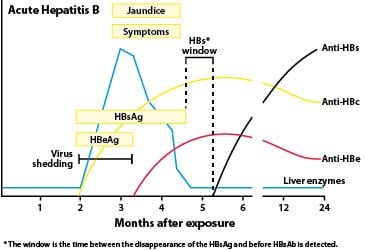If you’re preparing for the United States Medical Licensing Examination (USMLE) Step 1 exam, you might want to know which questions are most often missed by test-prep takers.
Check out this example from Kaplan Medical, and read an expert explanation of the answer. Also check out all posts in this series.
This month’s stumper
A 39-year-old man comes to the physician because of anorexia, malaise, dark urine and upper abdominal discomfort. His temperature is 37.9ºC (100.2ºF). Physical examination shows scleral icterus and moderate right upper quadrant tenderness. The liver is palpable below the right costal margin. Laboratory studies show:
- HBsAg: positive
- HBsAb: negative
- Anti-HBc IgM: positive
- HBeAg: positive
Which of the following will most likely change in his serologic findings when this patient enters the window period?
A. He will become HBcAg-positive
B. He will become HBc IgG-positive
C. He will become HBeAg-negative
D. He will become HBsAb-positive
E. He will become HBsAg-negative
The correct answer is E.
Kaplan Medical explains why
This patient has acute hepatitis B. The “window period” refers to that period in infection when neither hepatitis B surface antigen (HBsAg) nor its antibody (HBsAb) can be detected in the serum of the patient. It is an immunologically mediated phenomenon caused by the precipitation of antigen-antibody complexes in their zone of equivalent concentrations and, thereby, their removal from the circulation.
Because of this, the first thing that will happen in the window period is that the serum will become negative for the surface antigen (HBsAg) as that antigen is precipitated out of the serum by developing levels of its specific antibody (HBsAb). Serologic tests conducted during the window period will be positive for HBcAb and HBeAb.

Why you shouldn’t choose the other answers
Read these explanations to understand the important rationale for each answer.
Choice A: HBcAg is not typically measured in the serum during the symptomatic phases of hepatitis B infection. It would be found before the patient develops symptoms and would likely remain present as long as the patient has an active HBV infection, regardless of whether the patient is in the window period or not.
Choices B and C: Levels of anti-HBc IgG and HBeAg do not have a relationship to the window period. The antibody against the main core of the virus (HBcAb) is used to diagnose history or presence of an infection since it is the first antibody made by the patient, and it will remain in the body well after resolution of a HBV infection or in patients with chronic HBV infections. The HBeAg (a second core antigen) is found in the blood when virions are also present in the bloodstream. It is therefore used as a measure of how infectious the patient would be.
Choice D: Levels of HBsAb will not be detectable until there is antibody excess and the patient is leaving the window period.
Key tips to remember
- During the “window period” of hepatitis B infection, neither hepatitis B surface antigen (HBsAg) nor its antibody (HBsAb) can be detected in the serum of the patient.
- This is due to precipitation of antigen-antibody complexes in their zones of equivalence and, thereby, their removal from the circulation.
- Serologic tests conducted during the window period will be positive for HBcAb and HBeAb.
For more prep questions on USMLE Steps 1, 2 and 3, view other posts in this series.
The AMA and Kaplan have teamed up to support you in reaching your goal of passing the USMLE® or COMLEX-USA®. If you're looking for additional resources, Kaplan provides free access to tools for pre-clinical studies, including Kaplan’s Lecture Notes series, Integrated Vignettes, Shelf Prep and more.





